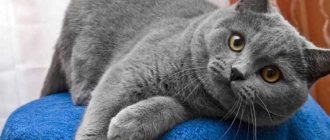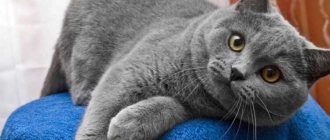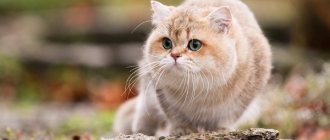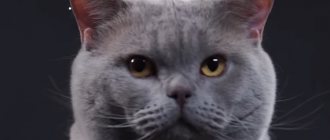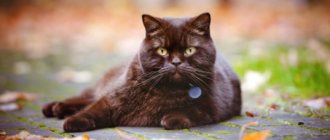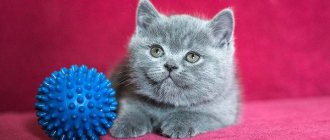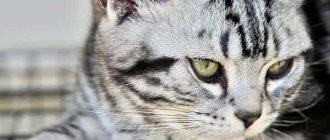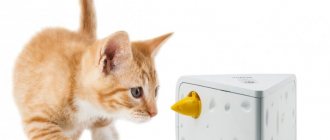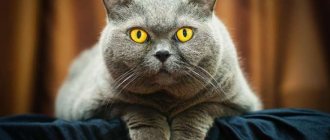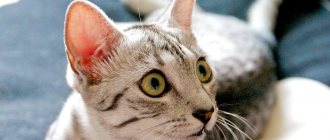Contents of a Black Briton
British cats are a fairly easy-to-care breed; if properly maintained, British cats can easily live up to 15-16 years of age without causing much trouble to the owner. Therefore, the key points that the cat owner should know are mainly related to the animal’s nutrition.
Feeding a British cat
The owner of the animal can choose two feeding options - natural food or a diet consisting of high-quality dry food. It is impossible to mix two types of diets, as this is fraught with gastrointestinal problems for your pet. If we talk about industrial ready-made food, then you need to choose the “super-premium” or “holistic” lines, if possible selecting the specific breed of food. Many brands offer food made and selected specifically for the British breed.
Royal Canin for British cats
However, modern food is not necessarily selected strictly for the breed - it is better to focus on the characteristics of the animal (homebody, castrated or sterilized animal, walking on the street, and so on). Each pack contains a table from which you can easily find out the daily dosage of food for a Briton - just weigh the animal and follow the manufacturer’s recommendations.
British cats are prone to obesity, so you should not overfeed your pet or leave food freely available.
An adult should be fed twice a day, morning and evening; the rest of the time there should be only clean, cool drinking water in the bowl - this is important!
To prevent your cat from suffering from excess weight, the serving size needs to be adjusted.
The natural nutrition of a British cat is based on fresh raw meat (turkey, veal, rabbit are preferred). There is no need to boil the meat, in which case it loses its beneficial properties, just pour boiling water over the piece before cutting and immediately offer it to the cat.
Food from the master's table is not suitable for the British; there is no need to cook porridge or soups for the cat - they negatively affect the digestive system of the predator. To raw meat you can add grated raw vegetables (pumpkin, carrots, zucchini), quail or chicken eggs, and finely chopped herbs. Every day a cat eating natural food should receive kefir or cottage cheese. You need to remember that in terms of the amount of protein, curd mass is equivalent to meat, and balance the diet based on this - an excess of protein “hits” the liver.
Fresh meat should occupy at least 60% of a small predator's bowl
In addition to meat, dairy products, vegetables and herbs, British cats should receive additional mineral and vitamin supplements - high-quality complex vitamins can be purchased at a pet pharmacy (Canina, 8 in 1, Beafar, Polidex).
British black cats benefit from adding a little kelp seaweed to their daily dose, which maintains and maintains the bright charcoal color of their coat. Dietary supplements for cats containing kelp are also sold in pet stores.
Treats with kelp for cats
Black British coat care
The short but thick coat of a British cat requires some attention from the owner - once a week the cat needs to be thoroughly combed with a slicker brush with droplets on the tips of the teeth or with a special massager. During the molting period, grooming procedures should be carried out more often - once every two days, carefully combing out the dead undercoat. A kitten must be taught to brush itself from a very early age, otherwise a wayward adult cat may resist.
British cats are washed once every six months, or when soiled, if the animal has access to the street or spends the summer season outdoors. For washing, special shampoo for animals should be used. For black Britons, we recommend lines of cosmetics designed specifically for dark coats: “Royal Groom Black Pearl”, “Ring 5 – Black Out”, “Kiss Black Bagheera” and the like.
The British are clean and do not need to be bathed often
General Content Rules
Like any cat, the British cat must regularly undergo the following procedures: annual vaccination and quarterly deworming treatment. If your pet has access to the street, during the spring-autumn season you need to treat it against ticks and also wear a flea collar. Also, cats walking outside should have a separate thin collar on which will hang a tag with the owner’s phone number.
Cats must be vaccinated
Contents of a Black Briton
Contrary to popular belief that the British are difficult to look after, the reality is completely different. If you follow simple rules of care, a four-legged animal can easily live up to 18, and sometimes 20 years.
There are just a few nuances that you should pay attention to.
Namely:
- Avoid hypothermia of animals and do not place their houses in drafts. Representatives of these breeds have weak eyes. Therefore, at the slightest breath of wind, their eyes begin to water and sour.
- Visit a veterinarian regularly, especially for owners of animals over 10 years old, and get vaccinated.
- Feed your cats correctly.
- Do not allow frequent matings (for cats), this weakens the immunity of fluffies, they begin to get sick often.
Caring for cats involves proper feeding. This can be high-quality dry food or canned food, as well as natural food.
First you need to decide, and then carefully select your diet. If preference is given to dry food, then it is better to choose the holistic or super-premium lines. Many brands offer food specifically for the British, taking into account their age.
At the same time, veterinarians advise choosing food based on the four-legged lifestyle. If the animal is overweight, then it is worth purchasing appropriate food. If the cat does not leave the house, therefore, it is necessary to purchase appropriate food. It's all written on the packs. In addition, veterinarians working in specialized pet stores will always give advice and help, so this will not be a problem.
Some owners worry that their British black kitten will go hungry while they are at work. Therefore, they leave the drying directly in the bowl, pouring it with a mountain. This cannot be done because, firstly, the feline’s stomach will quickly stretch out, and secondly, they will get used to the fact that they can eat as much as they want, and then they will not leave their feeder. Considering that the British are prone to obesity, doing this is strictly prohibited.
Animals must be given eggs at least a couple of times a week. The same applies to dairy products. True, there should not be an excess of them. To maintain the charcoal shade of the coat, you can add kelp to your food from time to time. If the cat is repelled by the smell, then it is worth buying vitamin complexes that contain these algae and giving them.
You should forget about food from the table. British black cats, like representatives of other colors, begin to get sick if they consume fat, salt and spices in excess. All this is present in the food that a person eats. All this is prohibited for animals.
Grooming
Many people believe that the British Shorthair black cat's coat does not need to be looked after. However, it is not. If the animal is not combed at least once a week, the hairs will begin to tangle and cough. Therefore, this procedure cannot be avoided. To do this, it is better to buy a soft brush that will not injure the skin.
Cats should not be bathed frequently. If the animal walks along the street, then “bath days” must be organized 2 times a year. For bathing, you should take shampoos designed specifically for black Britons. These cosmetics are sold in pet stores.
A little history of the breed
They are one of the oldest known breeds, descended from European domestic cats imported to England at the same time as the Roman invasion in the first century AD. Today it remains the most popular breed in its native country, as registered by the UK Governing Council for Cat Fancy (GCCF).
The origins of the British Shorthair most likely date back to the first century AD, making it one of the oldest identifiable breeds in the world.
It is believed that the Roman invasion originally brought Egyptian domestic cats to Britain. These animals were then interbred with the local European wild cat population. Over the centuries, their natural isolated descendants evolved into very large, robust beasts with short but very dense hair, to better withstand the rather harsh climatic conditions of their home islands. Based on artists' views, the modern British Shorthair is no different from this original type.
On the left you see blue colors. On the right are the tabby, red, cream and cinnamon varieties in the first photo, tortoiseshell in the second and bicolor in the third.
Selective breeding of the best specimens of this breed began in the nineteenth century, with an emphasis on developing an unusual blue-gray variant called the "British Blue" or "English type" (to distinguish it from the finer-grained "Russian").
Some sources directly credit British artist and cat lover Harrison Weir with the original concept for standardizing the breed. Others suggest that a group of breeders was involved in the selection.
The new British Shorthair was introduced at the first ever cat show, organized by Weir at the Crystal Palace in London in 1871, and enjoyed great initial popularity.
By the 1890s, with the advent of newly imported Persians and other longhair breeds, the British Shorthair was no longer as widely popular, and its breeding stock became critically rare during the First World War.
At least partly to save the breed, breeders mixed Persians with their bloodlines. The genes introduced in this way would eventually become the basis of the British Longhair. At that time, any longhaired cats produced were included in the Persian breeding program, as all blue cats were then rated together as non-de facto single breed options. Blue Shorthairs, the result of crossing the early British with Russian Blues, were also common.
After the war, in an attempt to maintain the breed standard, the GCCF decided to accept only third generation Perso-British Shorthair crosses for registration. This also contributed to the destruction of the pure breeding stock by the beginning of World War II, after which the Persian and Russian Blue were reintroduced to the list of acceptable crosses.
Blue kitten
In addition, felinologists have also worked with the French Chartreuse, another ancient breed that, although not genetically related to the British Blue, is very similar visually. Breeders devoted much attention to restoring the true English type, and by the late 1970s the British Shorthair had received official recognition from both the Cat Fanciers' Association (CFA) and the International Cat Association (TICA).
It is again the most popular cat breed in the UK, according to the GCCF 2013 registry.
Origin of color
The first British cat of Blue color appeared in 1871 and took first place at a cat show. The cat was introduced by breeder Harrison Ware. The appearance of the Briton charmed fans, but only in 1950 did she gain recognition in American felinology.
For over a hundred years, breeders have worked to achieve the perfect standard of the British Blue. To achieve the result, they were mated with various breeds of cats: Persian, French, and blue Russian cat. It has been established that the recessive Blue tone is a diluted black pigment. Therefore, the color varies over a wide spectrum from dark graphite to light gray, rich blue. Now certain standards have been established for the color of the breed; according to color, it is rated up to 25 points.
Breeders have difficulties with breeding; according to the rules of genetics, this is a recessive color and two Blue parents can produce the same kittens of both sexes. When mating with other colors, it is difficult to get blue kittens.
Eyes
Not only the beautiful, soft, shiny coat evokes admiration, but also the charming, large, round eyes. They are widely spaced relative to the nose, which gives them more expressiveness. The coat color of a British cat looks good in the photo in combination with their eyes, which are copper, orange, and golden.
Due to the yellow color of the eyes and the gray-blue color of the coat, the pure British cat is sometimes confused with a mixed breed from a Russian cat, but they are distinguished by the shape of the head and the full cheeks characteristic of the blue solid.
Breeding work
It is very difficult to obtain high-quality black offspring in the British breed, and sometimes even experienced professionals cannot predict the result in advance.
Breeding Black British
The choice of a breeding pair is the main issue of any breeding. In our case, it is desirable that future parents meet the following requirements:
- both had a standard black color - even, without spots or shades of color;
- were already untied and previously gave birth to offspring;
- had multigenerational pedigrees from which heredity could be studied.
The ideal parent pair to produce black offspring should be black in color
It goes without saying that at the time of mating both animals must be in good physical and psychological shape, completely healthy, promptly vaccinated and treated for all types of parasites.
Black kittens can be produced by parents with any coat color if they are carriers of the black gene. But a black father and mother, of course, give a much greater chance of getting black babies in the litter. Their wool will be of high quality, and the color will be rich if the pedigrees of the producers contain as few ancestors as possible with light colors: blue, peach, etc. In this case, the presence of striped, spotted and “marbled” ancestors is even more undesirable.
This combination may well produce black offspring, especially if the black parent is prepotent
An important specificity of the British, which must be taken into account when selecting a parent pair, is the presence in this breed of two blood groups, A and B, which it is very advisable not to mix when mating. If you do not adhere to this rule, the litter will be born healthy, but may die within three days. This is due to the fact that maternal colostrum produces special bodies that have a detrimental effect on the blood of “hybrid” babies. In this case, kittens can be saved by immediately switching to artificial feeding.
All British dogs grow and develop very quickly, but puberty comes quite late for them - as, indeed, for all large breeds. Only by four, and in some cases by five years, animals are fully formed physically and psychologically. So early matings are contraindicated for this breed.
Of course, you shouldn’t breed a cat every time she’s in heat - she needs to fully recover from the joys of motherhood. The optimal frequency of successful matings for a British cat is three times in two years. Litters are rarely large, and British cats make very good mothers.
British women are very caring mothers
Issues of castration and sterilization
The British breed usually has high hormonal levels. Therefore, when you decide to take a little Briton into your home, decide in advance whether you plan to get offspring from him in the future - by the way, the class of the animal and its price depend on this. If you are not going to engage in exhibitions and breeding work, it is better to spay or neuter your pet.
This operation will help maintain health, which is especially important for a cat. If she does not regularly bear offspring, then the reproductive system becomes vulnerable to the development of inflammatory processes, which is fraught with the appearance of very dangerous diseases - pyometra and even oncology. After sterilization, animals become much calmer, and cats stop marking their territory.
The optimal age for sterilizing a cat is from nine months to one and a half years, when regular estrus has already begun, but there has been no birth. It is better to castrate a cat at about one year of age.
If you do not plan to breed, sterilize the animal in a timely manner.
Take surgery very seriously. Sterilization (especially of cats) is a full-fledged operation that is performed under general anesthesia and requires time and attention for rehabilitation. Trust this procedure only to experienced specialists and carry it out in a veterinary clinic and not at home. The recovery process must also take place under the constant supervision and control of a veterinarian.
Eye color in black Britons
Among the variety of cats of the British breed, the following are distinguished:
- blue and purple shades;
- golden color, currently considered the most original and expressive;
- silver British cats, especially those with blue eyes;
- British chinchillas of all types of colors.
All Britons have blue eyes, but only up to four months. After this, the shade changes to gold. Some kittens may have green eyes, but breeders note that in this case the likelihood that the baby will turn black at the age of 6-7 months is zero.
Plain
In addition to blue, there are six more solid colors: black, white, chocolate, lilac, red, cream. The color is uniform and uniform, without white hairs, spots or patterns. The wool is soft, thick, plush.
Charcoal black plush Britons look extremely impressive, they have rich pigmentation of the undercoat, fur and skin, but purchasing such a kitten is not easy. This is due to the fact that during adolescence, kittens can change their coat color to chocolate.
The fur of a white British cat is snow-white, without yellowness or spots. In kittens, blue or black stripes on the forehead are acceptable, which disappear without a trace with age. It is difficult to obtain kittens with perfectly white fur, and breeding cats of this color is associated with the risk of producing sick offspring. Since 1997, breeding work has not been carried out with this color.
In warm chocolate color, richness and depth of shade are appreciated. The darker the color, the better. This color is called havana, or chestnut.
Considering the solid colors of British cats, lilac is the most difficult to imagine. This color is a combination of pink and blue. The paw pads and nose are colored to match the fur. Obtaining this color is the result of professional breeding. There is no gene responsible for the purple color. The goal is achieved by a rare combination of parental genes. Kittens are born a delicate, almost pink color, and the color of an adult animal resembles a latte.
Red British cats are most often called ginger cats. The wool is uniformly dyed, without stains or patterns. The nose and paw pads are brick red. Intensity of color is valued.
Delicate creamy Britons are often called beige or peach. Their nose and paw pads are pink.
Features of British hair care
There are also some differences regarding the hygiene and living conditions of black British cats.
- British fur coat color can vary depending on diet. For example, food containing beets is suitable for dark-colored cats. But a large amount of seafood on a cat’s menu can negatively affect the color of the paws and nose - these areas of the body will become lighter, in contrast to the main shade.
- When exposed to ultraviolet light, a black cat's fur becomes dull and takes on a gray tint. To restore color, you will have to limit the time your pet stays in direct sunlight.
Despite the short hair, the British cat needs regular brushing during shedding. The procedure is carried out several times a day using a special mitten or comb.
Silver and gold
Silver color is one of the most popular among British cats. It can be of the following types:
- shaded;
- veiled;
- smoky;
- tabby
Golden color is also not found in its pure form. This bright color is one of the most expensive among British cats. It can be represented by the following types:
- shaded;
- veiled;
- tabby
Ticked tabby, shaded and veiled colors are called chinchilla. It is the representatives of golden and silver colors that are called chinchilla and golden chinchilla.
How do kittens' eyes change?
The final eye color in cats is established by the age of 2 years. The process of changing the color of the iris is called reblooming. Most often it begins in the 4th week of a kitten’s life. In this case, the usual blue tint of the eyes is diluted with splashes of a different color. Gradually, these inclusions grow and the animal’s eyes acquire a constant shade.
So, if you have a preference for cats with a certain eye color, adopt a kitten at 4 months of age. At this time, it is already possible to determine what color of the pet’s iris will be. Later it may acquire greater depth and richness, but its basic tonality will remain unchanged. It is worth noting that eye color is not a feature of a particular breed. This is a purely genetic criterion, where blue color is a recessive trait.
If you have decided to become the proud owner of a British kitten, you probably have many questions about choosing and keeping your little friend. And the first thing you need to do is decide who you want to be your little friend - a cat or a female cat. Often people do not think about this issue while the kitten is small, but when the baby grows up, the situation changes, because a lot depends on the gender of the animal.
Experts say that cats are less demanding and more friendly by nature than cats; as for the British female sex, cats are very serious, jealous of their owners and strongly attached to them. But again, any animal is a personality, and cat riddles are not so easy to solve by looking at a cute little and fluffy kitten with a charming, naively playful look. And in any case, like any other cats, the British require a lot of attention, affection and love, while they are always sociable, trusting and really miss their owners.
When buying a kitten, many people immediately pay attention to the eye color of British kittens, it is amazingly beautiful - blue-gray! But here it should immediately be noted that with age, the color of the kitten’s eyes will change in any case, but more on this a little later, since first you need to choose the right age of the animal when purchasing. When choosing a pet, you should definitely take into account that the older he is, the better for you and for him.
Kittens up to a month old should not be separated from their mother at all, because they are still too small, need mother's milk and can even die from insufficiently developed immunity or stress
When choosing a pet, you should definitely take into account that the older he is, the better for you and for him. Kittens up to a month old should not be separated from their mother at all, because they are still too small, need mother's milk and can even die from insufficiently developed immunity or stress.
Moreover, if you like a certain eye color in British kittens
, then it is very difficult to determine this at a young age. Only after several months can we say what it will be like, since by then the first moult will have passed and the color will begin to change.
The final results will be clearly defined only by the year, but, nevertheless, already at four months the eye color of British kittens can be judged by the general tone. At this age, a specialist will already be able to tell you whether they will be yellow or dark orange.
You also need to pay close attention to ensure that the kitten’s eyes are clear and do not have a visible third eyelid or discharge.
How to determine the eye color of British kittens in advance? It is known for sure that British cats of classic color can only have copper-colored eyes (from amber-golden to rich dark copper); in this case, neither blue nor green eyes are allowed in adults. In other British breeds, eye color directly depends on coat color. The most diverse range is observed in British white cats; these beauties can have eyes of blue, gold, or all shades of copper colors. Another feature of white cats is the ability to have eyes of different colors, most often gold and copper shades.
By the way, there are many who want to buy just such an unusual and cute kitten with completely different eye colors.
In white, silver, golden British chinchillas, the eye color can be emerald green, and in color point cats, the eyes can also be blue.
Plush on the outside, tough on the inside. The character of the British.
When you look at the cheeky little plush, round on all sides, you have an uncontrollable desire to squeeze the Briton endlessly. And here you will be greatly disappointed - British cats do not tolerate familiarity! Although kittens may willingly play with their owner and cuddle, adult cats behave more than independently.
Silver tabby kitten plays with a teaser fishing rod
They rarely or never come to sit on your hands. If you start stroking a pet that is sleeping or minding its own business, the cat will most likely leave, or prove that sharp claws are hidden in its soft paws. All that remains is to humble yourself and caress the Briton only with your eyes.
The owners of these luxurious cats admit that sometimes they do not feel like their owners. Sometimes it seems that everything is the other way around: Mister Cat lives in the apartment, the rest are service staff.
“I am the queen, and you are the two-legged food giver.”
This does not mean that British cats do not need love and care. They seek attention from people just like other cat breeds - but only on their own terms. A curious animal may simply follow you from room to room, carefully observing what its person is doing.
The manners of the British are inherently respectable; they rarely rush around the apartment or jump on cupboards. If you get used to the scratching post in a timely manner, you won’t have to worry about the furniture. They are not mischievous or annoying.
British chocolate cat
British cats only vocalize on special occasions. If we are not talking about sexual heat or severe stress (a trip in the car, a visit to the veterinarian), some owners do not hear their pet meowing for months. Meowing while begging for food is beneath the dignity of these aristocrats. Rather, you will be haunted by the gaze of large round eyes, reproachful.
In general, the breed is considered quite phlegmatic: the British have a calm and even character. To prevent your pet from completely turning into a sofa cushion, excess weight should not be allowed to appear.
Too thick
British cats are not a suitable breed for families with children. Rarely does a Briton favor children: they are too noisy, too clingy and lacking in delicacy. No, a cat is unlikely to scratch a child, even if he pulls his tail. But the life of a Briton will turn into constant stress and the search for a reliable refuge, where no one will disturb him to take a peaceful nap. These cats are not ready to play for too long, and even more so, they do not like to be persistently petted. Explaining to a child that this teddy bear is inviolable will not be easy.
Get your little hands off me, little man!
Description of the breed
The physiology and appearance of the British were formed under high humidity in cold climates, therefore this breed has dense short hair that protects from cold and moisture.
Since British cats are excellent hunters, they are strong, hardy and unpretentious in food.
The breed standard describes the British as follows:
- The head has a wide skull and is round. The cheeks are developed, the cheekbones are wide, the muzzle is flattened and round.
- The nose is wide, straight and short.
- The ears are rounded and small, set wide and low.
- The eyes are round, at a great distance from each other, which exceeds the width of the nose.
- The body is massive, with a developed chest and good muscles.
- The limbs are powerful, but short. Paws are rounded.
- The tail is thick.
- Weight - Males weigh 10-13 kg, and females from 6 to 9 kg.
Wool protects cats well from the cold due to the developed undercoat. It does not adhere to the body, is thick and plush to the touch.
Sometimes there are longhaired British cats. A recessive gene is responsible for long fur, so a long-haired kitten cannot appear from ordinary parents.
People often confuse British and Scottish cats: some even seriously think that there is such a breed - the British Fold. The two different breeds should not be confused.
What breeds were involved in the creation of British cats
British cats are considered by some to be an aboriginal breed - one that formed on its own, without active human intervention. In many ways this is true. Cats were brought to the islands of Great Britain by Roman legionnaires many years ago. On an island isolated from the mainland, the cat population developed “in itself”, without the infusion of fresh blood, but with strict natural selection. After all, cats did not live in houses, but on farms, fields, grain barns and factories. As a result, large cats with heavy bones and dense, thick short hair roamed the streets of England.
British cream color
At the end of the 19th century, targeted selection of British cats began, and for some time the breed was called the “British Blue”. At first, blue was the only acceptable color, then it was the most common, but now the variety of colors of the British is amazing.
"Classic" blue color of British cats
The breed's numbers declined twice in the 20th century - after the First and Second World Wars. In order not to lose the British, they were crossed with ordinary outbred shorthair cats. And in order to return the desired rounded appearance of the head, they began to involve in the breeding of Persians.
It was not possible to obtain stable offspring, and the British began to be mated with Russian blue cats, as well as Chartreux cats. Then they returned to the infusion of Persian blood, weeding out kittens that were too snub-nosed or had long hair. It was the Persians who “gave” British cats more than 200 variations of coat color.
In 1982, the two breeds were finally separated: British and European Shorthair. At the same time, the British breed standard was written.
Content Rules
Proper care of an adult pet or kitten will preserve and prolong the health of the animal. British cats need regular coat care: combing, bathing, grooming. The fur of cats of this breed is thick and short, and the animals themselves are very clean and groom themselves thoroughly. But they need to be combed to get rid of lost hair and to add shine and shine to the coat. The cat licks the fallen hair and swallows it.
Hairs collect in the stomach in clumps and cause discomfort, this can lead to serious illnesses. Therefore, pets should be combed regularly and given special medications to prevent the accumulation of hair in the body.
It is also necessary to clean the ears and nose and trim the nails once every few weeks. You can help wash your cat's eyes daily. The teeth of the British also need to be monitored and periodically given special dry food for tartar. In addition, purebred individuals are susceptible to many genetic diseases.
British breed standard
To figure it out for sure, you need to delve into the approved British standard and at least approximately understand what a worthy representative of the breed should look like.
When choosing a black kitten, the future owner must be sure that he is purchasing a British cat, and not a cat with a similar phenotype.
Table 1. External features of British cats
| Parameter | Description |
| Head | As the British say: “The whole breed is in the head.” Indeed, British cats are distinguished by a characteristic large head, round in shape, with wide cheekbones and pronounced “chubby” cheeks. The forehead is round and flat, the nose is short and straight. |
| Chin | Strong, massive, straight (perpendicular to the mirror of the nose). The British jaw should not be narrowed or thin. |
| Ears | Small, low set, rounded at the tip. A Briton's ears should be at an angle of ninety degrees to each other, if the apex of the angle falls on the bridge of the animal's nose. |
| Frame | Short, squat, muscular. Both male and female cats are distinguished by their massiveness, but not looseness. The animals are distinguished by a wide chest and powerful hips. |
| Limbs | Medium length, thick and strong. |
| Tail | Wide at the base and rounded at the tip. Medium length, quite thick. |
| Eyes | Large, wide-set and open. The iris of British cats reaches its final shade quite late, perhaps by the animal’s year. |
| Wool | Thick, dense and shiny, with good undercoat. Ideally, a Briton's fur coat should resemble stuffed plush, so that the animal's skin is not easy to touch. |
What should/shouldn't the head of a thoroughbred Briton look like?
Why do kittens' eyes change color?
Eye color in cats depends on the amount of coloring pigment. Therefore, the reason for the change in eye color is the accumulation of melanin in the eyeball during the development of the visual organs. However, blue color is a recessive trait, which is why eyes of this shade are very rare.
Otherwise, they are sweethearts and are not allowed at home. The British cat's coat requires minimal care, simply brushing it once a week. It is good to remove dead hair more often during the licking period. The chests do not need to be reduced if they do not protrude even when pulled. Overgrown nails can be avoided by purchasing scrapers.
Standards and features. The British cat is a medium-large breed. The body is quite thick and strong. The limbs are short, with thick rounded paws. The tail is short and strong and has a blunt tip. The head is round, massive, with a wide skull set on a short, thick neck. Adult cats are characterized by a massive "face mask". The eyes are large and round, spaced far apart, with color depending on the color of the coat - blue cats have orange eyes, colored blue cats, silver-green cats.
At the moment of embryo formation, there are approximately 3 dozen pigment centers in the body of the future kitten. Migrating throughout the animal’s body during its development, the bulk of them settle in the fur. At the same time, the eyes account for only a small proportion of pigments, which continue to accumulate after the kitten is born. In the process of their accumulation, a change in the color of the kitten’s eyes occurs.
The ears are medium in size with rounded toes. The British cat weighs from 4 to 8 kg. The British cat's coat is short, dense, plush, and rich in undercoat. The coat is said to be crispy and does not stick to the body. It's so good that the cat doesn't mind winter or any bad weather. It can be black, chocolate, red, blue, lilac, cream, tortoiseshell, chocolate, blue, lilac tortoiseshell, white or tortoiseshell, another color - brindle, silver brindle or with badges.
The British cat seems like a real English lady who loves her world. He has a balanced and pleasant character, intelligent, tolerant, friendly and gentle. Although she keeps her reserved distance, she enjoys cuddling and enjoys company. However, her character does not require much attention, and incoming visits are preferred to be viewed from afar.
Tortoiseshell colors
Spots of two colors are evenly distributed throughout the body.
This can be a combination of rich colors (black, chocolate or cinnamon) with red, as well as blue (or purple) with cream.
The colors are distributed equally and look harmonious. The thick coat is short and soft.
The paw pads are pink or black, and the eyes are copper and gold shades. Cream slippers on the paws or short stripes on the nose are possible.
The most common varieties:
- Chocolate cream
British Chocolate Cream Tortoise
- Blue-cream
British blue-cream tortoise
- Lilac-cream
British cat lilac-cream tortoiseshell
- Black tortoiseshell
Photo of a British black tortoiseshell cat
This color occurs only in female cats; due to the peculiarities of genetics, cats are not tortoiseshell.
Other photos of British tortoiseshell cats
#gallery-1 { margin: auto; } #gallery-1 .gallery-item { float: left; margin-top: 10px; text-align: center; width: 25%; } #gallery-1 img { border: 2px solid #cfcfcf; } #gallery-1 .gallery-caption { margin-left: 0; }
Height and weight of British cats
Representatives of the British breed have a rather large build by nature and, accordingly, the British also weigh quite a bit. In addition, the weight of an adult cat depends on its lifestyle and diet.
The normal weight of a newborn British kitten, regardless of whether it is blue or chocolate, should be between 60 and 140 grams. Moreover, its size ranges from 9-14 cm. How to name a British kitten >>How to name a kitten based on the length of its fur >>
Considering that the British grow up to the age of 5, we suggest finding out in more detail what size the animal grows to each year.
The table shows the weight of British people depending on gender.
| British age | British cat weight | British cat weight |
| 1 year | 2-4 kg | 4-6 kg |
| 2 years | 2.5-4.5 kg | 4.5-6.8 kg |
| 3 years | 2.8-4.8 kg | 4.7-7 kg |
| 4 years | 3.8-5 kg | 4.9-7.5 kg |
| 5 years | 4-6 kg | 5-8 kg |
So, the average weight of a mature British adult can be from 4 to 8 kg. Today, the largest representative of the breed, named Chest, weighs 12 kg! Moreover, this is not the maximum weight of a pet. Since he is only 4 years old, the cat will probably grow up.
The British cat is truly a bright representative of the oldest purebred pets. Its extraordinary resemblance to a children's plush toy can inspire anyone to believe in the best and calm them down after hard everyday life.
More articles on this topic: All about the British breed
Types of British
Health of British cats
History of the British breed
Upbringing
Purchasing a kitten usually begins with a reservation. Then, only from 2 months of age the animal can be given to new owners. Why do you have to wait so long? Kittens, like children, are connected with their mother for the first time after birth, and not only with food. Mom teaches them the first steps and many other things that are invisible to us humans. After 2-3 months, the kitten is ready to leave its mother and move to a new family to live independently. In addition, during these 3 months, breeders teach kittens the litter tray, diet and scratching post.
After the kitten has moved to a new home, it needs to continue to be raised. You need to feed your pet in one specific place and at the same time. After moving, the toilet must first be installed in a visible place for the kitten so that he understands that his litter box is with him. The tray should be gradually moved towards the toilet, and after some time the kitten will only go to its tray in the place where it is convenient for you.
Color point
Color-point Britons have a light body color and dark markings on the face, ears, paws, and tail - points. This color is also called Himalayan or Siamese. The color of the points corresponds to one of the main colors, and the body color is in harmony with it.
Types of color point:
- solid;
- shaded;
- veiled;
- bicolor;
- smoky;
- turtle;
- tabby
